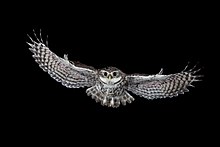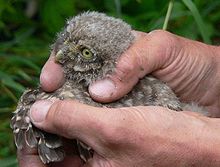Little owl
![]()
This article describes the Little Owl, for the genus of the same name (Athene) see Little Owls.
The Little Owl (Athene noctua) is a small, short-tailed owl of the family Strigidae. The range of the Little Owl extends across Eurasia and North Africa. It is a characteristic inhabitant of the tree-steppes with sparse or low vegetation and prefers to hunt on the ground. Once a territory has been chosen, it is usually occupied for several years and sometimes even for life.
The Little Owl was already considered a bird of wisdom in ancient Greece and was a symbol of the goddess Athena. This is also referred to by its scientific name, which translates as 'nocturnal Athena'. This is why the expression "carrying owls to Athens" refers to the little owl and its depiction on ancient drachma coins. In German-speaking areas, the name "Steinkauz" is a reference to the fact that this owl species breeds not only in tree hollows, but also in barns, chapels and wine cellars made of stone. In Central Europe, Little Owl populations have been declining sharply for several decades. The main cause of this decline is the destruction of habitats that provide suitable environmental conditions for the Little Owl.
In 1972, the Little Owl was Bird of the Year in Germany. In Switzerland, it was chosen as Bird of the Year for 2021.
Name
The bird species was formerly, but is also occasionally still today regionally simply called Kauz or Käuzchen or Käuzlein, although other smaller owl species also end in "-kauz", such as the Tawny Owl or the Great Horned Owl. The word Kauz occurs exclusively in the German language and has been recorded as a bird name since the 15th century. It has also been known as an epithet for people in Hesse since the 14th century and still refers to a strange person in phrases such as "funny owl", which can probably be seen as a comparison to the bird's reclusive lifestyle. The naming of the bird species is traced back to the sound-imitating Indo-European root *gō̌u-, *gū- "call, cry", i.e. to the cry audible in the dark, which is also the primary naming motif for the word "owl". There are also folk etymological explanations, for example that the term comes from the cat, namely because of the word similarity, the similar face, the sharp vision at night and the hunting of mice. However, such folk etymologies are generally rejected in linguistics today.
Description
Adult Little Owls
The Little Owl reaches a body size of 21 to 23 centimeters. The wingspan is between 53 and 58 centimeters. The size corresponds to that of a song thrush, but the Little Owl appears larger than the latter due to its loose plumage and broad-rounded head. It lacks feather ears and its low forehead makes it look flat-headed. There is no noticeable sexual dimorphism. The weight of males varies between 160 and 240 grams, that of females between 170 and 250 grams. Adult birds reach maximum weight in December and January. They are lightest in June and July.
The facial veil is only weakly pronounced in the Little Owl and limited above by whitish over-eye stripes. The eyes are lemon to sulphur yellow. The dark sepia-brown upperparts of the body have whitish creamy yellow or greyish white drop spots and cross bands, with the spotting on the upperparts of the head being particularly dense, small and stripe-like, and larger and more rounded on the front back. On the nape of the neck, the Little Owl has a conspicuous white V-shaped pattern that converges with a white nuchal band and encloses darker parts of the plumage (known as the occipital face). On the hand wings, cream-coloured to beige-brown spots form five to six transverse bands. Two to three such cross bands are usually visible on the arm wings. On the arm coverts, however, the spot pattern varies individually very strongly. The underwing coverts, on the other hand, are pale and have a grey to blackish mottling. The throat is whitish and separated from the breast by a beige or rusty brown collar. The underside of the body is yellowish white with sepia-brown, irregular longitudinal stripes. Particularly on the breast plumage, these longitudinal spots are very dense and broad, making the ground colour only slightly prominent. The legs are white feathered and the toes are covered with bristle-like feathers.
Adult Little Owls begin their annual moult when the young birds fly out. The moulting period lasts from 98 to 115 days and is completed in Central Europe at the end of October or beginning of November.
Nestlings and young birds
The down dress of newly hatched Little Owls is white, dense and short. Their hatching weight is only between 10 and 12 grams. Apart from the rear side of the barrel joint, the legs are also down to the toes. The wax skin is pinkish at first, the bill and the claws are whitish or greyish pink. The wax skin turns a dark purplish gray within the first week of life. The beak initially turns a bluish gray with a yellow tip and then becomes increasingly olive yellow. The claws, on the other hand, turn black. The eyes open from the 8th to 10th day of life.
The first beginnings of the grey-brownish nestling dress (mesoptile) appear from the 5th day of life. It first appears on the shoulder and arm covers, later on the back of the head, neck, in the middle of the back as well as on the chest and thigh. The development of the mesoptile is completed by the 21st day of life. The typical markings of the species can already be seen on the face. The breast plumage is roughly longitudinally spotted to striped. There are conspicuous rows of white spots on the palms and shoulders. Around the 40th day of life the large plumage is fully developed. The mesoptile is replaced by the juvenile plumage in Central Europe in the period from August to November. This juvenile plumage resembles the adult annual plumage, but is somewhat paler and more rusty brown. The spots are creamy yellow to rusty brown in colour and less contrasting. On the top of the head and on the anterior dorsum the spots are even less conspicuous than in adult birds. Young tawny owls show their first adult plumage shortly after completing their first year of life.
Behavior
The Little Owl covers short distances in a straight-line rowing flight, while for long distances a woodpecker-like wave flight is characteristic. Hunting Little Owls also show shaking and gliding flights. Little Owls usually fly just above the ground surface. Owls that fly up from a higher vantage point and then rise again form a U-shaped flight line. Before taking off from a control room, they often show an excitement-induced kicking at the site. Because the body weight is high in relation to the wing area and the flight feathers are relatively short and hard, unlike the distinctly nocturnal owl species, the flight of the Little Owl is not silent and audible to humans at close range. On the other hand, there is no deliberate flapping of the wings, as is the case with the long-eared owl, the burrowing owl and the rough-legged owl.
Little owls move very often on the ground. They are able to run so fast that they can even catch up with a fleeing field mouse. They then run with very long-legged strides and occasionally turn on shorter jumps, while they tend to trundle in short steps when moving more slowly. Little Owls can often be observed perching on chimneys, fence posts, boulders, utility wires, or poles during the day. Resting Little Owls often fluff up their plumage loosely and retract their flat-shaped head, giving them a spherical appearance. In light rain, they spread their wings wide and ruffle their feathers. Occasionally they can be seen basking in the sun. When they do this, their wings are limply open, their plumage is plumed and their face is turned towards the sun. An approaching human is often fixed by the Little Owl with short jerky head movements. Similar to enemy encounters, the Little Owl also frequently displays a so-called vertical curtsy, in which the Owl ducks into an almost horizontal posture and then straightens up with heels extended.

Little Owl in Flight

Approx. 3½ week old Little Owl taken out of nest tube for ringing. Berger Hang, Frankfurt am Main
Questions and Answers
Q: What is the scientific name of the little owl?
A: The scientific name of the little owl is Athene noctua.
Q: Where does the little owl live?
A: The little owl lives in temperate and warmer parts of Europe, Asia (east to Korea), and North Africa. It was also introduced into Britain at the end of the nineteenth century, and into the South Island of New Zealand in the early twentieth century.
Q: What type of habitat does it prefer?
A: The little owl prefers habitats such as farmland, woodland fringes, steppes and semi-deserts. It is camouflaged, making it especially hard to see if its background is wood or stone covered with lichen.
Q: What does it eat?
A: The little owl feeds on insects, earthworms, other invertebrates and small vertebrates such as mice and shrews.
Q: How do males defend their territories?
A: Males have territories which they defend against intruders by chasing away any potential competitors or predators that enter their area.
Q: How many eggs are laid in a clutch?
A: A clutch of about four eggs is typically laid in spring by a female little owl.
Q: Who incubates the eggs?
A: The female incubates the eggs while the male brings food to her at first for herself then later for when they hatch.
Q:How long do chicks stay in nest before leaving ?
A:The chicks leave their nest at around seven weeks old after both parents hunt and bring them food during this time period .
Search within the encyclopedia